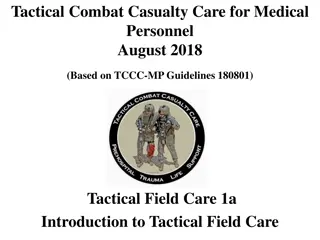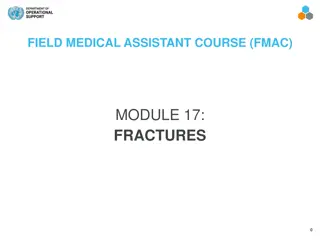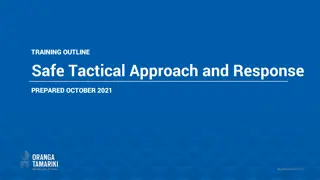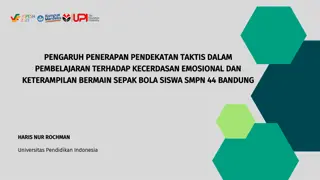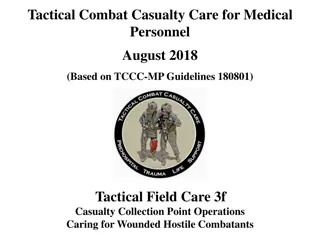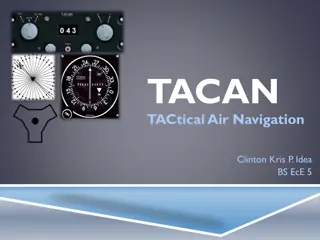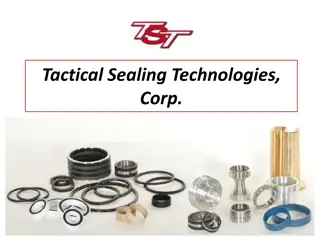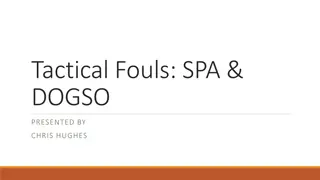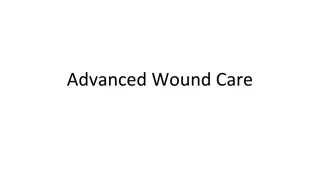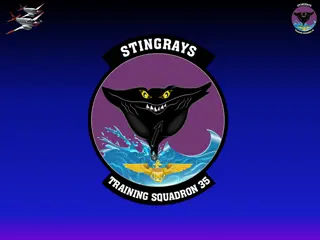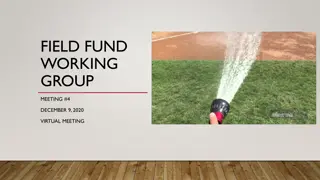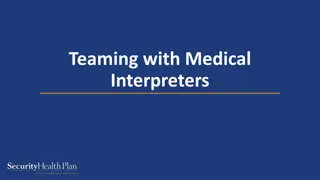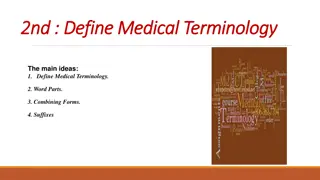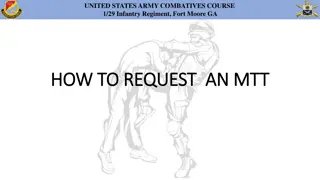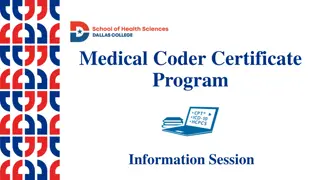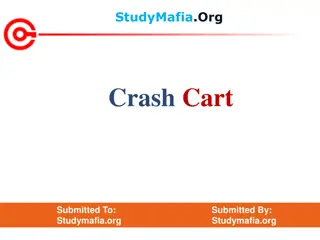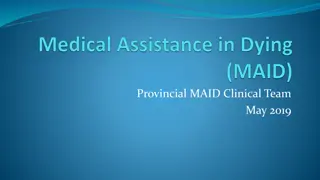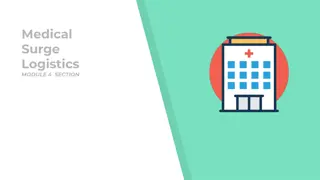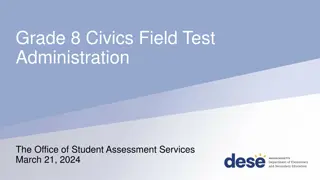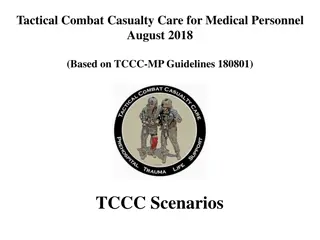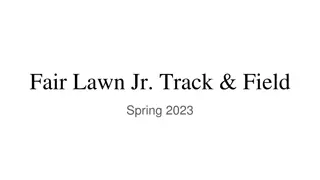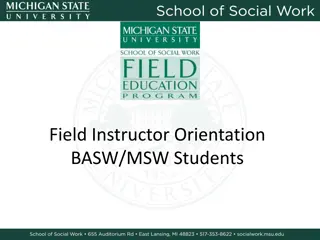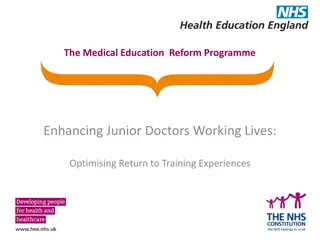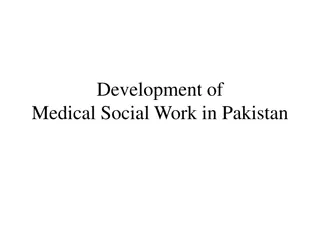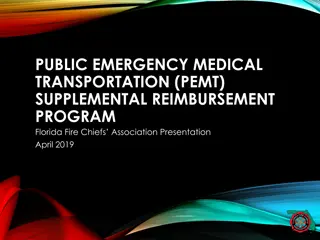Tactical Field Medical Training Overview
This comprehensive training module covers essential topics for medical personnel operating in combat or peacekeeping scenarios. It includes pre-evacuation procedures, documentation of care, and the phases of Tactical Field Care. Emphasis is placed on effective communication with evacuation assets, proper casualty documentation, and the importance of quick decision-making in high-stress situations. The training aims to equip personnel with the skills needed to provide immediate and effective medical assistance in the field.
- Medical Training
- Tactical Field Care
- Pre-evacuation Procedures
- Communication with Evacuation Assets
- Combat Scenarios
Download Presentation

Please find below an Image/Link to download the presentation.
The content on the website is provided AS IS for your information and personal use only. It may not be sold, licensed, or shared on other websites without obtaining consent from the author. Download presentation by click this link. If you encounter any issues during the download, it is possible that the publisher has removed the file from their server.
E N D
Presentation Transcript
FIELD MEDICAL ASSISTANT COURSE (FMAC) MODULE 19: PRE-EVACUATION PROCEDURES 0
TACTICAL FIELD MEDICAL AID (TFMA) ROLE-BASED TRAINING SPECTRUM ROLE 1 CARE NONMEDICAL PERSONNEL Buddy First Aid Field Medical Assistant You are HERE MEDICAL PERSONNEL Paramedic Nurse Doctor 1
STUDENT LEARNING OBJECTIVES TERMINAL LEARNING OBJECTIVE T21 Given a combat peacekeeping or non-combat peacekeeping scenario, perform pre- evacuation procedures during Tactical Field Care in accordance with TFMA Guidelines EO91 Identify the importance of and techniques for communicating casualty information with evacuation assets and/or receiving facilities EO92 Identify the information requirements and format of an evacuation request EO93 Identify the recommended evacuation prioritization for peacekeeping casualties EO94 Demonstrate the communication of evacuation request information and modified medical information report requirements T22 Given a combat peacekeeping or non-combat peacekeeping scenario, perform documentation of care during Tactical Field Care in accordance with TFMA Guidelines EO95 Identify how to document casualty information on the Casualty Card and the proper placement of that card on the casualty. EO96 Demonstrate the proper documentation of care on a trauma casualty in Tactical Field Care 2
Three PHASES of TFMA 1CARE UNDER FIRE 2TACTICAL FIELD CARE 3TACTICAL EVACUATION CARE RETURN FIRE AND TAKE COVER COVER AND CONCEALMENT Quick decision-making: Consider scene safety Identify and control life- threatening bleeding Move casualty to safety Basic Management Plan: Maintain tactical situational awareness Triage casualties as required MARCH PAWS assessment More deliberate assessment and treatment of unrecognized life- threatening injuries: Pre-evacuation procedures Continuation of documentation NOTE: This is covered in more advanced TFMA training! YOU ARE HERE 3
PRE-EVACUATION COMMUNICATION COMMUNICATE WITH EVACUATION AND MEDICAL ASSETS Communicate with evacuation system to coordinate EVAC using 4- Line CASEVAC request Keep the Casualty Card up to date Communicate with the casualty if possible Encourage Reassure Explain care each step of the way Communicate immediately with tactical leader for Status Evac requirements Casualty treatment 4
PRE-EVACUATION COMMUNICATE RELEVANT CASUALTY DATA HANDOFF WITH MEDIC OR CASEVAC When handing off the casualty to the Medic or CASEVAC, provide the Casualty Card, including any additional information as needed MIST report May change as the casualty status and interventions performed change Conveys additional evacuation information that may be required by Helps better prepare peacekeeping commanders receiving facility Communicate with evacuation system: 4-Line CASEVAC request MIST Report Mechanism of injury Injuries Symptoms Treatment Relay the information following your standard operating procedures (SOPs) Document all assessment and medical care (including interventions and medications) on the Casualty Card 5
PRE-EVACUATION REQUESTING EVACUATION OF CASUALTIES Although the Field Medical Assistant is not a medical person, they may need to initiate the medical evacuation request Depending on the tactical situation and available assets, the casualty may be evacuated by CASEVAC CASEVAC Movement of a casualty from Point of Injury to a Medical Treatment Facility 6
PRE-EVACUATION MEDEVAC REQUEST KEY POINTS BE AWARE: This video demonstrates the TCCC 9- LINE MEDEVAC. The UN equivalent is the 4-LINE CASEVAC. 9-LINE MEDEVAC / MIST REPORT Video can be found on DeployedMedicine.com Every UN member must be prepared to transmit a CASEVAC request A CASEVAC request is NOT a direct medical communication with medical providers, but a means of communicating evacuation requirements so aircraft resources can be launched as needed Gather all information needed before initiating transmission Use appropriate and mandated communications security and brevity codes when transmitting a CASEVAC request in accordance with the operational plan 7
PRE-EVACUATION 4-LINE: CASEVAC REQUEST LINES 1-4 8
SKILL STATION Communication and Documentation (Skills) 4-Line & Mist Report 9
PRE-EVACUATION CASUALTY CATEGORIES Ground medical personnel will determine EVAC categories of casualties EXAMPLES: URGENT URGENT SURGICAL PRIORITY ROUTINE CONVENIENCE <2 hours to save life, limb, or eyesight <2 hours to nearest surgical unit <4 hours or could deteriorate to urgent <24 hours Not a medical necessity Tourniquets Corrected haemorrhage Traumatic Brain Injuries (TBIs) Needle Decompression of the Chest (NDCs) Cricothyroidotomy Major internal bleeding Massive head trauma Compensated shock Broken arm with loss of distal pulse 2nd-degree burns to a large portion of the abdomen or extremities Abrasions Cardiac arrest Small fractures Frostbite 2nd-/3rd-degree burns >70% of body surface area (BSA) Used for administrative purposes for casualty movement 10
PRE-EVACUATION OVER-CATEGORIZATION OVER-CATEGORIZATION: the tendency to classify a wound or injury as being more severe than it actually is Historically AND currently problematic Proper casualty categorization is needed to ensure that those casualties in greatest need are evacuated first and receive the care required to help ensure their survival Casualties will be picked up as soon as possible, consistent with available resources and pending missions A. Urgent: <2 hours to save life, limb, or eyesight B. Urgent Surgical: <2 hours to nearest surgical unit C. Priority: <4 hours or could deteriorate to urgent D. Routine:<24 hours E. Convenience: not a medical necessity 11
PRE-EVACUATION COMMUNICATE 1. WITH THE CASUALTY Encourage, reassure, and explain care 2. WITH TACTICAL LEADERSHIP Provide leadership with the casualty s status and location 3. WITH MEDICAL PERSONNEL Discuss with the responding medics the casualty s injuries and symptoms, as well as any medical aid provided DOCUMENT 1. CASUALTY ASSESSMENT FINDINGS 2. MEDICAL AID RENDERED 3. CHANGES IN CASUALTY STATUS MIST Report is generated from Cas Card 12
SKILL STATION Communication and Documentation (Skill) Cas Card 13
SUMMARY We discussed the 4-Line and MIST Reports We discussed requesting an evacuation of a casualty We identified over-categorization We identified key information to relay to tactical leadership 14
CHECK ON LEARNING With whom do you communicate in a casualty situation? What information does the MIST Report contain? Who should complete the Casualty Card? Where can you find the Casualty Card? 15


